M119 howitzer
The M119 howitzer is the US designation for the L118 light gun, a lightweight British 105 mm howitzer also used by the United States Army. It can be easily airlifted by helicopter, or dropped by parachute. It does not need a recoil pit.
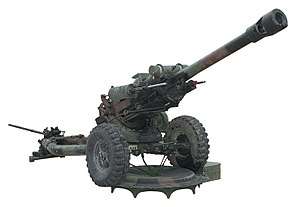 M119 Howitzer | |
| Type | Towed howitzer |
| Place of origin | United Kingdom/United States |
| Service history | |
| Used by | United States Army, Saudi Arabian Army,[1] |
| Production history | |
| Manufacturer | Joint Manufacturing Technology Center of Rock Island Arsenal |
| Produced | 1989–2013[2] |
| Variants | M119, M119A1, M119A2, M119A3 |
| Specifications (M119A1) | |
| Mass | With BII: 5,110 lb (2,320 kg) Without BII: 4,690 lb (2,130 kg) Cannon alone: 1,389 lb (630 kg) |
| Width | 5 ft 10 in (1.78 m) |
| Height | Combat: 7 ft 3 in (2.21 m) Travel: 4 ft 6 in (1.37 m) |
| Crew | 5 to 7 |
| Caliber | 105 mm (4.13 in) |
| Elevation | −100 to +1,244 mils |
| Traverse | Left or right 100 mils |
| Rate of fire | Maximum: 8 rpm for 3 minutes Sustained: 3 rpm for 30 minutes |
| Maximum firing range | Charge 7: 17,500 m (10.9 mi) Charge 8 (With RAP): 19,500 m (12.1 mi) |
| Sights | 3 × M90A2 telescope, M137A1 panoramic telescope |
Development
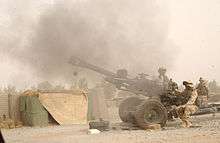
The howitzer was designed and produced by the British Royal Ordnance Factories as the L118 light gun. In the L118 configuration, the 105 mm ammunition is cased separate loading ammunition (not semi-fixed projectile and propelling charge as sometimes stated). The L118 entered service with the British Army in 1976 and is used by parachute and commando field artillery regiments. It saw combat during the Falklands War, where the 30 guns in action fired up to 400 rounds per gun per day, mostly at "charge super"—i.e., the most powerful propellant charge available. The L119 is the L118 reconfigured to fire NATO-standard US/Nato 105 mm semi-fixed ammunition.
In 1987 an agreement was reached to produce the L119 under license by the US as the M119, to replace the M102 howitzer. It entered service with 7th Infantry Division, Fort Ord, California, in December 1989. Some improvements were made to produce the M119A1, including increasing its extreme low temperate envelope from −30 °C to −45 °C, improving maintainability. The Army renewed contracts for the M119 to be produced by the Rock Island Arsenal-Joint Manufacturing & Technology Center (RIA-JMTC) at Rock Island, Illinois into the year 2013. The 105 mm M20A1 cannon was produced by US Army Watervliet Arsenal.
The M119 is currently fielded with all Regular Army and National Guard infantry brigade combat teams, including those in the 10th Mountain, 82nd Airborne, and 101st Airborne divisions, and the 173rd Airborne Brigade Combat Team. Other divisions may be of mixed composition between armor, Stryker, and infantry brigade combat teams, with armor having M109A6s Paladins and Stryker having M777s for their fires battalions. For example, two of four are IBCTs with M119s in the 25th Infantry Division. National Guard light field artillery battalions assigned to IBCTs also have M119s, for example the 86th IBCT (Mountain) headquartered in Vermont. It is routinely airdropped in airborne operations and sling-loaded under CH-47 Chinook or UH-60 Black Hawk helicopters in air assault operations.
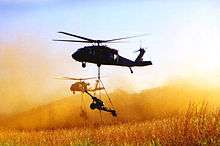
In April 2009, the M119A2 howitzer was being fielded by the 4th Infantry Combat Brigade of the 3rd Infantry Division to provide better support in operations in Afghanistan and Iraq. It was the only brigade in the division equipped with it, as the other three brigades were "heavy" brigades and therefore equipped with the M109A6 Paladin.
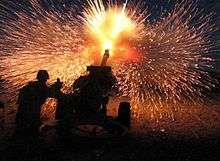
Alpha Battery of the 1st Battalion, 320th Field Artillery Regiment, 101st Airborne Division received their first upgraded M119A3 howitzers in July 2013, and became the first unit to operate it in theater when they were deployed to northeast Afghanistan in early February 2014. The digitally upgraded M119A3 includes software and hardware component upgrades, GPS for navigation, a digital gunner's display, and digital communication between each gun and the fire direction center to speed up the process of receiving firing data and firing shells. Firing platoons were also equipped with larger, also digital M777A2 howitzers, and the M119A3 was more admired for being faster, lighter, and easier to change azimuth of fire. The A3-model retains manual capabilities of the A2-model, so occasions where digital capabilities were lost allowed crews to easily transition back to the analogue mode of operation and continue their missions.[3]
Project Manager for Towed Artillery Systems (PM TAS) has developed several upgrades for the M119A3 including digital fire control, increased low temperature capability from −25 to −51 °F (−32 to −46 °C), and the M20 breech. The recoil system is also being upgraded, as the legacy system had reliability issues with the recuperator, buffer, and variable recoil linkage (which sets recoil length based on elevation); it had a lot of moving parts needing constant maintenance and adjustment during operations with high replacement rates of spares that are complex to manufacture and require specialized tooling to assemble, increasing costs and causing availability problems. The redesigned system operates the same, but modifies and simplifies some components, including a new buffer and recuperator with a majority of the components removed, and adds the Suspension Lockout System (SLOS) that fixes recoil length at 25 in (64 cm), which removes variable-recoil hardware, reduces stress on the carriage, and lowers buffer rod forces; the new system reduces cost, number of parts by 40 percent to 75, and overall weight by 45 lb (20 kg).[4]
Ammunition
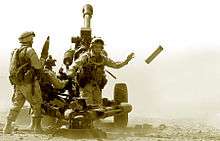
The M119A1 fires all standard NATO semi-fixed ammunition as well as special rocket-assisted projectiles, including:
- M1 high explosive
- M314 illuminating
- M60/M60A2 smoke
- M913 HERA range: 19.5 km
- M760 HE range: 11.5 km
- M1130A1 HE PFF BB range: 17 km[5]
- M915 DPICM
Prime mover
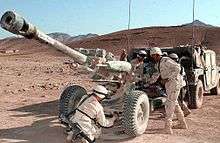
The M119 is towed in the US Army by the M1097 High Mobility Multi-Purpose Wheeled Vehicle (HMMWV).
Variants
- M119: original copy of the L119
- M119A1: minor improvements, including fire control and maintenance
- M119A2: improved sight package consisting of telescope (M90A3) or panoramic telescope (M137A2)
- M119A3: modernized version with digital fire control system and an inertial navigation system for self location, entered service in April 2013 with A Battery 3/319th Field Artillery at Fort Bragg, NC[6][7][8]
References
- "Artillery: The Arabian Light". www.strategypage.com. Retrieved 27 August 2017.
- "US Army Fact Files - Towed Howitzer (105mm) M119A1/A2 - Equipment Portfolio". www.army.mil. Retrieved 27 August 2017.
- 'Top Guns' fire first M119A3 in Afghanistan - FortCampbellcourier.com, 22 May 2014
- M119 howitzer still plays critical role for Army - Army.mil, 9 September 2015
- "New ammunition combines four artillery cartridges into one", Army.mil, 14 November 2011
- "Gun Devils first in Army to fire digital howitzer". army.mil. Retrieved 27 August 2017.
- "Gun Devils first in Army to fire digital howitzer". dvidshub.net. Retrieved 27 August 2017.
- Artillerymen at Fort Bragg first unit in U.S. Army to receive digitized towed howitzer M119A3 - Armyrecognition.com, May 18, 2013
External links
| Wikimedia Commons has media related to M119 105 mm howitzer. |